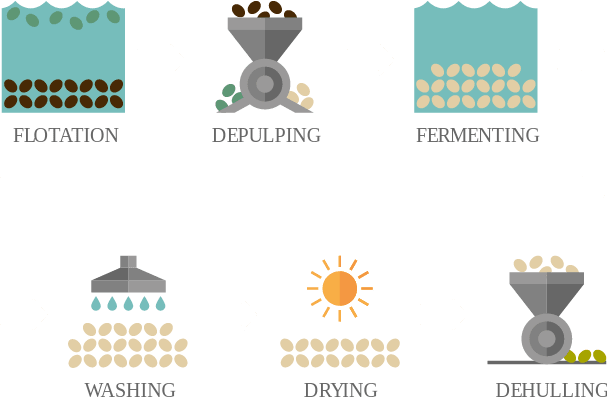COFFEE PROCESSING METHODS
Ever wondered how coffee cherries become your flat white? Find out the different ways coffee is processed.
COFFEE PROCESSING METHODS
Ever wondered how coffee cherries become your flat white? Find out the different ways coffee is processed.

The most water-intensive method, but it produces the best clarity of flavour. Coffee cherries are sorted by water and fermented in water, before finally being dried out - for a bright and clear coffee.
WASHED COFFEES ARE:
Fresh and bright
High in acidity
Known for the clarity of their flavours
Full of apple, pears, blueberry, and dark chocolate notes
THE PROCESS
Coffee cherries are picked at their optimum ripeness
Cherries are sorted in a floatation tank, where unripe ones float and are removed
The cherries’ pulp is mostly removed, and they’re placed in water tanks to ferment for 18-36 hours
After this, beans are rinsed and dried in the sun - for one-to-two weeks
The cherries are then dehulled, to remove the papery ‘parchment’ layer left

PULPED NATURAL COFFEE BEANS
Similar to Washed processing, but missing steps - the Pulped Natural method was designed to still produce a clean cup, while conserving water and reducing pollution.
PULPED NATURAL COFFEES ARE:
Syrupy sweet
Full bodied
Low in acidity
Full of stewed fruits, milk chocolate and cocoa powder flavours
THE PROCESS
Coffee cherries are picked at their optimum ripeness
Cherries are sorted in a floatation tank, where unripe ones float and are removed
The skin, pulp and most of the mucilage of the cherry is then removed
The remaining beans are then dried for two-three weeks
The cherries are then dehulled, to reveal the green bean

HONEY COFFEE BEANS
No, this doesn’t actually involve any honey. It’s called that because the golden, sticky layer of mucilage looks a little like the sugary stuff. And it does product a sweet, clean cup!
HONEY COFFEES ARE:
Moderately sweet
Low in acidity
Known for good cup clarity
Full of plum, cherry, hazelnut, almond and cashew flavours
THE PROCESS
Coffee cherries are picked at their optimum ripeness
Cherries are sorted in a floatation tank, where unripe ones float and are removed
The skin and pulp of the cherry is then removed
The remaining beans are then dried for two-to-three weeks
The cherries are then dehulled, removing the final ‘parchment’ layer

NATURAL COFFEE BEANS
The most traditional method of processing coffee, and one of the trickiest to get a consistent cup from. The cherry is left to dry in its entirety, so the bean has the most exposure to its sugars.
NATURAL COFFEES ARE:
Full bodied, with bold flavours
Low in acidity
Sometimes inconsistent
Full of stewed fruits, milk chocolate and cocoa powder flavours
THE PROCESS
Coffee cherries are picked at their optimum ripeness
The cherries are laid out on tables or patios, to dry out
Frequent raking and turning takes place, for even fermentation
After several weeks, they reach their optimum moisture level
The cherries are then dehulled, to separate out the green beans
